Contextual Analysis
The topic of our project is the participation in LinkedIn Learning courses among members of the UMD community. We decided to focus on this issue because our initial perception was that there were not many students taking advantage of free access to those courses, the benefit that their UMD student status provided.
To gain full perspective in our conceptual inquiry into the subject, the work domain that we considered included all UMD affiliates who share the eligibility to no-fee access to LinkedIn Learning services; therefore, it included all three groups: students, faculty members, and non-faculty employees. In the course of the inquiry in this broad context, we were able to conclude rather quickly that the problem of no-participation was heavily related to lack of adequate information about this benefit and it mainly pertained to students because, as it turned out, UMD’s HR Department has developed rather effective ways of conveying this information to UMD employees through their website and managerial initiative regarding employee continuous education program. As a consequence to these findings, we have decided to narrow down our analysis to only student work domain and concentrate our efforts on identifying student’s information gathering habits as work activities relative to the problem being researched.
During contextual inquiry, our main sources of data collection were in-person interviews and a relatively comprehensive survey sent out to UMD affiliates, mostly students. Similarly to the survey, we tried to standardize the format and questions asked during in-person interviews. The aggregate results of both types of inquiries provided us with ample enough data to be able to draw preliminary conclusions as to the nature of the problem. The following are the highlights of that process.
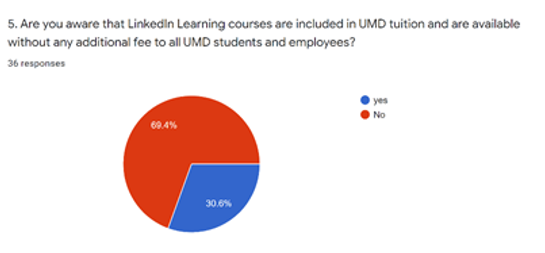
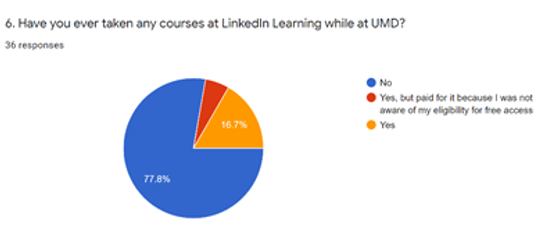
Contextual Analysis
The topic of our project is the participation in LinkedIn Learning courses among members of the UMD community. We decided to focus on this issue because our initial perception was that there were not many students taking advantage of free access to those courses, the benefit that their UMD student status provided.
To gain full perspective in our conceptual inquiry into the subject, the work domain that we considered included all UMD affiliates who share the eligibility to no-fee access to LinkedIn Learning services; therefore, it included all three groups: students, faculty members, and non-faculty employees. In the course of the inquiry in this broad context, we were able to conclude rather quickly that the problem of no-participation was heavily related to lack of adequate information about this benefit and it mainly pertained to students because, as it turned out, UMD’s HR Department has developed rather effective ways of conveying this information to UMD employees through their website and managerial initiative regarding employee continuous education program. As a consequence to these findings, we have decided to narrow down our analysis to only student work domain and concentrate our efforts on identifying student’s information gathering habits as work activities relative to the problem being researched.
During contextual inquiry, our main sources of data collection were in-person interviews and a relatively comprehensive survey sent out to UMD affiliates, mostly students. Similarly to the survey, we tried to standardize the format and questions asked during in-person interviews. The aggregate results of both types of inquiries provided us with ample enough data to be able to draw preliminary conclusions as to the nature of the problem. The following are the highlights of that process.

*Based on answers from 36 participants, 25 of them had no idea that as UMD affiliate they were entitled to free LinkedIn Learning services; this comes to almost 70% of those surveyed. Similarly, from 10 students interviewed in person, only 2 knew that they could take LinkedIn Learning courses for free.

*The alarming discovery was finding out that among the surveyed there were 2 students who actually took courses at LinkedIn Learning while being UMD students and paid for them because they were not aware of their eligibility for free access ( in aggregate, 2 students out of 36 reflects 5.6 %)
Important Note: when someone signs up to LinkedIn Learning using non-institutional email, there is no way for system to know that they are part of the institution which grants them free or discounted access, therefore this information needs to be either conveyed during enrollment or the sign up process be conducted through the link from the institution to LinkedIn Learning (in UMD case it is the link provided on the page at the following url address: https://linkedinlearning.umd.edu/ )
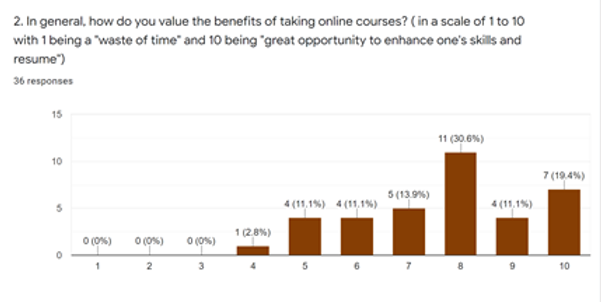
*It is also worth pointing out that most surveyed considered online courses in general a valuable way to enhance one’s skills and resume. In the scale from 1 to 10, the total of 27 participants rated it at 7 or higher (it corresponds to 75%). Similar sentiment was observed among those interviewed in-person as well.
Notable part of our contextual inquiry oscillated around determining work activities corresponding to the process of students obtaining information about any benefits that they are entitled to. This part of our endeavor was accomplished in two ways, the team’s internal discussion about our own experiences and usual channels in gathering information as UMD students, and the second one was including in the conducted survey one question that called for open ended written response:

Nearly half of the responders suggested school originated email announcements. Another frequent suggestion was “including the information (aka link to LinkedIn Learning) on either Testudo or ELMS main page”.
WAAD
Every team member brainstormed to come up with WAAD. Starting from the main LinkedIn Learning node we thought of different nodes that will interact with LinkedIn Learning such as Companies, Students, Schools & Professors, and added them to the WAAD. After adding nodes, we thought of interactions and actions that could happen between nodes. After identifying them, we added them as a description by arrows.
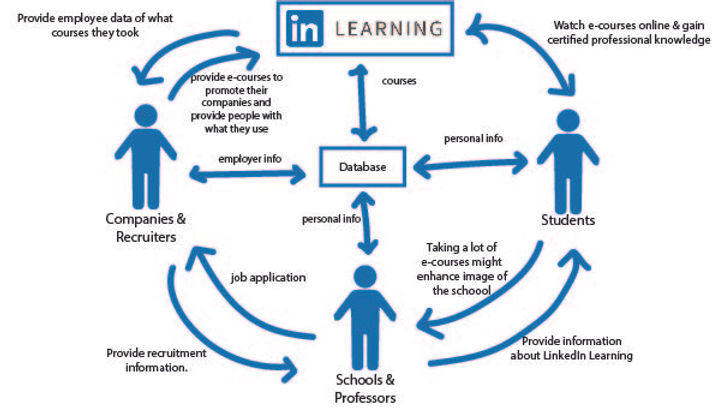
The main problem for the project is that a lot of students are unaware about LinkedIn Learning. And one of the reasons why students don’t know a lot of it is because there is not much information sharing happening about LinkedIn Learning. From the WAAD, the only part that is directly giving information about LinkedIn Learning is “Schools and Professors” and even they are not doing a great job. There is no action from “Companies and Recruiters” to “Students” that’s related to giving information on LinkedIn Learning. Therefore, students are less informed about LinkedIn Learning services, and miss out on achieving the benefit that the service gives. Also LinkedIn Learning itself doesn’t provide much information about their services to students as not many of them know about the detailed benefits they could gain through using their services.
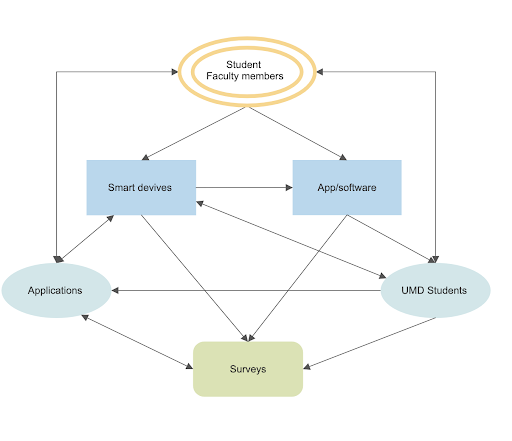
The major work roles include; the objective clients such as students, faculty members, and non-faculty employees. Sub-roles are those related to major roles, including UMD students, faculty members, and non-faculty employees that work in UMD. Machine roles include the app/software for surveys, smart devices where the app/software is installed for taking pictures and videos.
